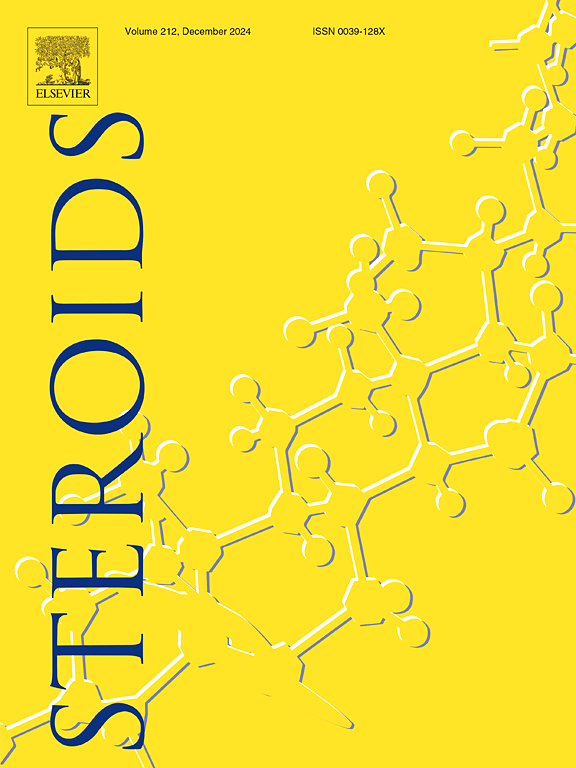在小鼠模型中,17β-雌二醇通过抑制 Beclin1 的甲基化延缓心脏衰老。
IF 2.1
4区 医学
Q4 BIOCHEMISTRY & MOLECULAR BIOLOGY
引用次数: 0
摘要
心脏内源性衰老会随着年龄的增长而逐渐改变和加剧。最近的研究表明,17β-雌二醇(17β-E2)是一种具有多种生物活性的雌激素,包括预防血管衰老。然而,17β-E2如何对抗心脏老化仍是未知的。为了更好地了解17β-E2在心脏衰老动物模型中的抗衰老作用,本研究探讨了Beclin1和自噬活性的潜在机制。材料与方法:本研究采用d-半乳糖和卵巢切除术建立雌性小鼠衰老模型。用超声心动图评价心脏功能,用RNA-seq分析17β-E2处理小鼠心肌组织的基因表达谱。采用qPCR和Western blotting检测心肌组织Beclin1、LC3、P62、ATG5的表达水平。心肌组织中Beclin1启动子区甲基化水平通过MSP和BSP检测。结果:心脏老化小鼠经17β-E2处理后,心脏功能得到改善。17β-E2恢复EF(增加1.25倍)和FS(增加1.2倍)至接近正常水平。通过rna测序和基因集富集分析(Gene Set Enrichment Analysis, GSEA)分析,我们发现17β-E2在心脏衰老小鼠心肌组织中进一步富集了自噬信号通路,并且我们还发现17β-E2抑制介导自噬信号激活的Beclin1启动子区甲基化。结论:总体而言,我们的数据表明,17β-E2对心脏衰老小鼠的抗衰老作用是通过关键的Beclin1启动子区甲基化抑制和随后的自噬信号激活介导的,这可能是一种可能的预防心脏衰老的治疗方法。本文章由计算机程序翻译,如有差异,请以英文原文为准。

17β-estradiol delays cardiac aging through suppressing the methylation of Beclin1 in a murine model
Introduction
Cardiac endogenous senescence will gradually change and aggravate with age. Recent research showed that 17β-estradiol (17β-E2), an estrogen with numerous biological activities including the prevention of vascular senescence. However, how 17β-E2 against cardiac aging is still unknown. This work addressed the underlying mechanism with regard to Beclin1 and autophagy activity to better understand the anti-senescent effect of 17β-E2 on a well-established animal model of cardiac aging.
Material and methods
In this study, an aging model in female mice was established using d-galactose and ovariectomy. Cardiac function was evaluated by echocardiography, RNA-seq was performed to analyze the gene expression profiles of myocardial tissues from 17β-E2 treated mice. Additionally,The levels of Beclin1, LC3, P62, and ATG5 in myocardial tissues were assessed using qPCR and Western blotting. Methylation levels of the Beclin1 promoter region in myocardial tissues were determined by MSP and BSP.
Results
The findings demonstrated that cardiac aging mice treated with 17β-E2 had improved heart function. 17β-E2 restored EF(increase 1.25-fold) and FS(increase 1.2-fold) to near-normal levels. By RNA-sequencing and Gene Set Enrichment Analysis (GSEA) analysis, the autophagy signaling pathway was further enriched in the myocardial tissue of cardiac aging mice treated with 17β-E2, and we also discovered that 17β-E2 suppress the methylation of Beclin1 promoter region, which mediate the activation of autophagy signal.
Conclusions
Overall, our data showed that 17β-E2′s anti-senescent effect on cardiac aging mice was mediated by the crucial suppression of methylation in the Beclin1 promoter area and subsequent activation of the autophagy signal, which may present a possible therapeutic approach to prevent cardiac aging.
求助全文
通过发布文献求助,成功后即可免费获取论文全文。
去求助
来源期刊

Steroids
医学-内分泌学与代谢
CiteScore
5.10
自引率
3.70%
发文量
120
审稿时长
73 days
期刊介绍:
STEROIDS is an international research journal devoted to studies on all chemical and biological aspects of steroidal moieties. The journal focuses on both experimental and theoretical studies on the biology, chemistry, biosynthesis, metabolism, molecular biology, physiology and pharmacology of steroids and other molecules that target or regulate steroid receptors. Manuscripts presenting clinical research related to steroids, steroid drug development, comparative endocrinology of steroid hormones, investigations on the mechanism of steroid action and steroid chemistry are all appropriate for submission for peer review. STEROIDS publishes both original research and timely reviews. For details concerning the preparation of manuscripts see Instructions to Authors, which is published in each issue of the journal.
 求助内容:
求助内容: 应助结果提醒方式:
应助结果提醒方式:


